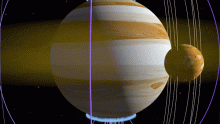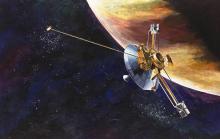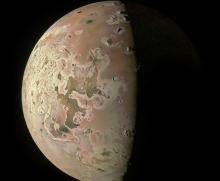Listen to today's episode of StarDate on the web the same day it airs in high-quality streaming audio without any extra ads or announcements. Choose a $8 one-month pass, or listen every day for a year for just $30.
You are here
Bookends
The two brightest objects in the night sky other than the Moon bracket the early evening sky like a pair of bookends. Venus is the brighter of the two. It’s the magnificent “evening star,” low in the west as night falls. At the same time, Jupiter is on the opposite side of the sky — in the east-southeast.
Venus looks so bright for several reasons. It’s covered by bright clouds that reflect most of the sunlight that hits them. It’s close to the Sun, so there’s a lot of sunlight for the clouds to reflect back into space. And it’s close to Earth, so a lot of that reflected light shines our way.
Jupiter, too, is blanketed by bright clouds. But it’s much farther from both Sun and Earth. As a result, it gets much less sunlight than Venus does, and it reflects less toward us.
But Jupiter is the biggest planet in the solar system — about a dozen times wider than Venus. So while a given area on Jupiter reflects much less sunlight our way than the same-sized patch on Venus, there’s just so much of Jupiter that it shines brilliantly. Right now, in fact, it’s glowing at its brightest for the entire year — the second-brightest planet in the night sky.
There’s a short window for seeing Venus and Jupiter as bookends. That’s because Venus drops from view about an hour and a half after sunset. But Jupiter is lining up opposite the Sun, so it remains in view all night.
Tomorrow: high spots and low spots on the Moon.
Script by Damond Benningfield






